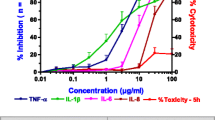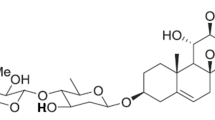Abstract
Introduction
In order to determine the mechanism of triterpenes, a class of secondary metabolites in plants, in modulating progression of vascular atherosclerotic lesions, we isolated three ursane triterpenoids (euscaphic acid, tormentic acid and 2α-hydroxyursolic acid) from aerial part of Salvia miltirrhiza Bge. and fed LDLr−/− mice the isolated compounds at a dose of 10 mg/kg p.o. for 24 weeks.
Materials and methods
The treated mice were raised with a cholesterol-enriched (1.25%) diet. Implying serum and aorta MCP-1 analysis, we found that all mice treated with the compounds exhibited a significant reduction of whole body and vascular inflammation.
Results
The reduction of macrophage cells’ number in aortic atherosclerotic lesions suggests that triterpenes treatment results in the development of a more stable plaque phenotype. Analysis of the structure-activity relationships demonstrates that compounds with a β-orientated hydrogen-bond forming group at C-3 exhibit more potent anti-atherogenic effect than the α-counterpart on the development of atherosclerosis and xanthoma. However, the biological activities of the compounds are significantly reduced when they have C-19 hydrogen-bonds.
Conclusion
These Results suggest that down-regulation of MCP-1 is the main mechanism for antiatherogenic activity of triterpenes and MCP-1 might play important roles in the development of atherosclerosis and xanthoma.
Similar content being viewed by others
Reference
Shishodia S, Majumdar S, Banerjee S, Aggarwal BB. Ursolic acid inhibits nuclear factor-kappaB activation induced by carcinogenic agents through suppression of IkappaBalpha kinase and p65 phosphorylation: correlation with down-regulation of cyclooxygenase 2, matrix metalloproteinase 9, and cyclin D1. Cancer Res 2003;63:4375–83.
Cichewicz RH, Kouzi SA. Chemistry, biological activity, and chemotherapeutic potential of betulinic acid for the prevention and treatment of cancer and HIV infection. Med Res Rev 2004;24:90–114.
Zhu YM, Shen JK, Wang HK, Cosentino LM, Lee KH. Synthesis and anti-HIV activity of oleanolic acid derivatives. Bioorg Med Chem Lett 2001;11:3115–8.
Ma C, Zhang HJ, Tan GT, Hung NV, Cuong NM, Soejarto DD, et al. Antimalarial compounds from Grewia bilamellata. J Nat Prod 2006;69:346–50.
Ma CM, Cai SQ, Cui JR, Wang RQ, Tu PF, Hattori M, et al. The cytotoxic activity of ursolic acid derivatives. Eur J Med Chem 2005;40:582–9.
de las Heras B, Rodriguez B, Bosca L, Villar AM. Terpenoids: sources, structure elucidation and therapeutic potential in inflammation. Curr Top Med Chem 2003;3(2):171–85.
Pozo M, Castilla V, Gutierrez C, de Nicolas R, Egido J, Gonzalez-Cabrero J. Ursolic acid inhibits neointima formation in the rat carotid artery injury model. Atherosclerosis 2006;184(1):53–62.
Somova LI, Shode FO, Ramnanan P, Nadar A. Antihypertensive, antiatherosclerotic and antioxidant activity of triterpenoids isolated from Olea europaea, subspecies africana leaves. J Ethnopharmacol 2003;84(2–3):299–305.
Andrikopoulos NK, Kaliora AC, Assimopoulou AN, Papageorgiou VP. Inhibitory activity of minor polyphenolic and nonpolyphenolic constituents of olive oil against in vitro low-density lipoprotein oxidation. J Med Food 2002;5:1–7.
Lee WS, Im KR, Park YD, Sung ND, Jeong TS. Human ACAT-1 and ACAT-2 inhibitory activities of pentacyclic triterpenes from the leaves of Lycopus lucidus TURCZ. Biol Pharm Bull 2006;29(2):382–4.
Kuroda M, Mimaki Y, Sashida Y, Kitahara M, Yamazaki M, Yui S. Securiosides A and B, novel acylated triterpene bisdesmosides with selective cytotoxic activity against M-CSF-stimulated macrophages. Bioorg Med Chem Lett 2001;11:371–4.
Yui S, Ubukata K, Hodono K, Kitahara M, Mimaki Y, Kuroda M, et al. Macrophage-oriented cytotoxic activity of novel triterpene saponins extracted from roots of Securidaca inappendiculata. Int Immunopharmacol 2001;11:1989–2000.
Ross R. Atherosclerosis: an inflammatory disease. N Engl J Med 1999;340:115–26.
Libby P, Ridker PM, Maseri A. Inflammation and atherosclerosis. Circulation 2002;105:1135–43.
Luster AD. Chemokines: chemotactic cytokines that mediate inflammation. N Engl J Med. 1998;338:436–45.
Yla-Herttuala S, Lipton BA, Rosenfeld ME, Sarkioja T, Yoshimura T, Leonard EJ, et al. Expression of monocyte chemoattractant protein 1 in macrophage-rich areas of human and rabbit atherosclerotic lesions. Proc Natl Acad Sci USA 1991;88:5252–6.
Brown MS, Goldstein JL. A receptor-mediated pathway for cholesterol homeostasis. Science 1986;232:34–47.
Ishibashi S, Brown MS, Goldstein JL, Gerard RD, Hammer RE, Herz J. Hypercholesterolemia in low density lipoprotein receptor knockout mice and its reversal by adenovirus-mediated gene delivery. J Clin Invest 1993;92:883–93.
Banno N, Akihisa T, Tokuda H, Yasukawa K, Higashihara H, Ukiya M, et al. Triterpene acids from the leaves of Perilla frutescens and their anti-inflammatory and antitumor-promoting effects. Biosci Biotechnol Biochem 2004;68:85–90.
Ismaili H, Sosa S, Brkic D, Fkih-Tetouani S, Ilidrissi A, Touati D, et al. Topical anti-inflammatory activity of extracts and compounds from Thymus broussonettii. J Pharm Pharmacol 2002;54:1137–40.
Ishibashi S, Goldstein JL, Brown MS, Herz J, Burns DK. Massive xanthomatosis and atherosclerosis in cholesterol-fed low density lipoprotein receptor-negative mice. J Clin Invest 1994;93:1885–93.
Tangirala RK, Rubin EM, Palinski W. Quantitation of atherosclerosis in murine models: correlation between lesions in the aortic origin and in the entire aorta, and differences in the extent of lesions between sexes in LDL receptor-deficient and apolipoprotein E-deficient mice. J Lipid Res 1995;36:2320–8.
Libby P, Schoenbeck U, Mach F, Selwyn AP, Ganz P. Current concepts in cardiovascular pathology: the role of LDL cholesterol in plaque rupture and stabilization. Am J Med 1998;104:14S–8S.
Orchard GE, Wilson Jones E, Russell Jones R. Verruciform xanthoma: an immunocytochemical study. Br J Biomed Sci 1994;51:28–34.
Takeya M, Yoshimura T, Leonard EJ, Takahashi K. Detection of monocyte chemoattractant protein-1 in human atherosclerotic lesions by an anti-monocyte chemoattractant protein-1 monoclonal antibody. Human Pathol 1993;24:534–9.
Fruebis J, Gonzalez V, Silvestre M, Palinski W. Effect of probucol treatment on gene expression of VCAM-1, MCP-1, and M-CSF in the aortic wall of LDL receptor-deficient rabbits during early atherogenesis. Arterioscler Thromb Vasc Biol 1997;17:1289–302.
Tanaka E, Shimokawa H, Kamiuneten H, Eto Y, Matsumoto Y, Morishige K, et al. Disparity of MCP-1 mRNA and protein expressions between the carotid artery and the aorta in WHHL rabbits one aspect involved in the regional difference in atherosclerosis. Arterioscler Thromb Vasc Biol 2003;23:244–55.
Brand K, Page S, Rogler G, Bartsch A, Brandl R, Knuechel R, et al. Activated transcription factor nuclear factor-kappa B is present in the atherosclerotic lesion. J Clin Invest 1996;97:1715–22.
Marumo T, Schini-Kerth VB, Fisslthaler B, Rudi B. Platelet-derived growth factor-stimulated superoxide anion production modulates activation of transcription factor NF-kB and expression of monocyte chemoattractant protein 1 in human aortic smooth muscle cells. Circulation 1997;96:2361–7.
Shin KM, Kim RK, Azefack TL, David L, Luc SB, Choudhary MI, et al. In vitro anti-inflammatory activity of 23-hydroxyursolic acid isolated from Cussonia bancoensis in murine macrophage RAW 264.7 cells. Planta Med 2004;70:803–7.
Balanehru S, Nagarajan B. Protective effect of oleanolic acid and ursolic acid against lipid peroxidation. Biochem Int 1991;24:981–90.
Heo HJ, Cho HY, Hong B, Kim HK, Heo TR, Kim EK, et al. Ursolic acid of Origanum majorana L. reduces Abeta-induced oxidative injury. Mol Cells 2002;13:5–11.
Chen XL, Zhang Q, Zhao R, Medford RM. Superoxide, H2O2, and iron are required for TNF-α-induced MCP-1 gene expression in endothelial cells: role of Rac1 and NADPH oxidase. Am J Physiol Heart Circ Physiol 2004;286:H1001–7.
Bismar H, Diel I, Ziegler R, Pfeilschifter J. Increased cytokine secretion by human bone marrow cells after menopause or discontinuation of estrogen replacement. J Clin Endocrinol Metab 1995;80:3351–5.
Author information
Authors and Affiliations
Corresponding author
Rights and permissions
About this article
Cite this article
Zhang, Q., Chang, Z. & Wang, Q. Ursane Triterpenoids Inhibit Atherosclerosis and Xanthoma in LDL Receptor Knockout Mice. Cardiovasc Drugs Ther 20, 349–357 (2006). https://doi.org/10.1007/s10557-006-0509-4
Published:
Issue Date:
DOI: https://doi.org/10.1007/s10557-006-0509-4




